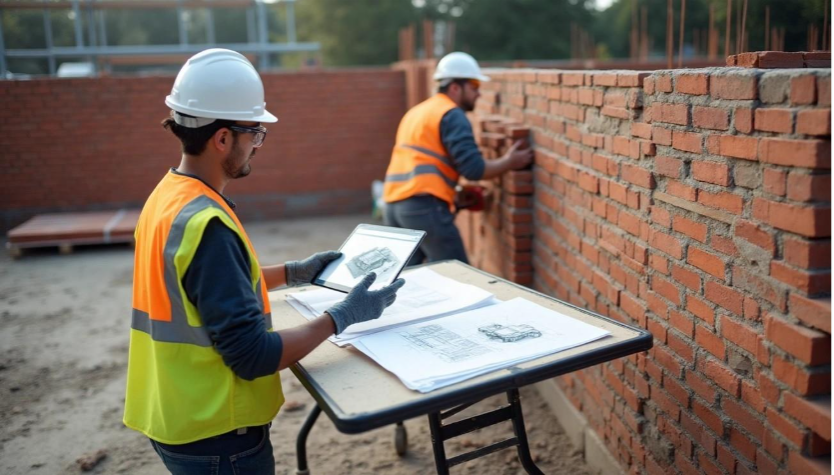Cost Savvy Guide for Project Owners.

Best Estimating Services
Construction estimating services, brickwork has been a mainstay of human construction since the earliest ages, with evidence stretching back to 2600 BC. Yet, correctly calculating the number of bricks in wall projects remains essential to residential construction, renovation, and DIY makeovers. A typical wall, 4m long × 3m high × 0.23m thick, requires approximately 1,380 bricks, with an additional 5-10% to account for breakage and cuts. It is this degree of accuracy that has made construction estimation services a must-have for current building projects. In the planning of brickwork, even the slightest inaccuracies can result in serious issues.
Trade experts usually base their estimates on established formulas, for instance, the one that eight bags of masonry cement will lay 1,000 modular bricks. With accurate construction estimating, we can avoid the expensive overruns and delays that often plague most projects. Estimating services in California USA, need specialized knowledge for determining wall area and volumes so that your material purchases are what your project actually needs. Throughout this article, we’ll examine how professional estimating services can rescue your next brick construction project from costly mistakes and wasteful overruns. How Brick Miscalculations Impact Construction Budgets. Accurate material estimation is at the heart of budget control on construction. A KPMG survey indicates 70% of construction projects have run over and have delays, with just 31% of projects within 10% of budget over the last three years. The figures identify the mass cost in terms of finance from miscalculation, especially in the case of brick construction, where miscalculations accumulate for the project.
Unforeseen Overruns Due to Inaccurate Estimating Services and Underestimating Quantities
Incorrect brick quantity estimations have a direct effect on financial performance. When initial estimates do not include all the requirements, projects are subjected to major budgetary stress. Construction profit margins in the first quarter declined by 27% in 2023 because of material expenses and labor shortages, indicating the dire effect of miscalculations.
In essence, accurate brick estimation involves not only calculating the bricks required for the wall area, but also providing for waste factors. Skilled estimators usually add a minimum of 5% to net brick quantities for waste and breakage, whereas mortar calculations have to have a 15-25% buffer. If these allowances are not allowed for, projects rapidly overspend as work advances.
Professional estimating construction services avoid these overruns by making complete quantity projections that consider all factors, such as bond trends, minimizing waste, and regional differences in brick size.
Delays Caused by Reordering and Delivery Shortfalls
Material shortages are one of the most critical causes of worldwide construction delays. Inadequate estimation has a domino effect: shortages stop production while reordering incurs costs and lengthens timelines. Additionally, reordering problems extend beyond cost to also involve color inconsistency and size tolerance issues, possibly affecting the look of the completed project.
These delays have huge financial implications- project delays account for a 15% loss in project value and are estimated to contribute to losses of around 1.58 trillion euros worldwide. The reordering cycle creates cascading impacts:
- Work stops at the affected area
- Rush orders typically cost more than planned purchases
- Delivery times extend the project timeline
- Labor crews stand idle or are rescheduled
Construction estimating assistance avoids such situations by accurate takeoffs and material measurement, guaranteeing sufficient supplies to order the first time.
Labor Inefficiencies due to Imprecise Planning
Labor inefficiency is an unseen expense of brick misestimates. Studies reveal that 35% of the time for construction professionals is consumed by unproductive tasks, and more than 14 hours a week are spent on searching for project details, conflict resolution, and rework.
Most importantly, low labor productivity is one of the main causes of cost overruns in construction projects. For masonry in particular, productivity is affected by some important factors:
- Poor work planning and unrealistic scheduling
- Lack of proper supervision methods
- Inexperience and a lack of skills among workers
- Complications in stretcher and header bonding that affect working efficiency
These inefficiencies translate to direct financial losses. When masons must stop work to wait for materials or when brick patterns must be reworked due to miscalculations, labor costs increase while productivity decreases.
Construction estimation services resolve these issues by offering reliable material predictions that allow effective labor planning. By identifying specific quantities and factoring in bond patterns, openings, and wastage, skilled estimators establish the basis for effective workforce management for the duration of the project.
Step-by-Step Breakdown of Brick Quantity Estimation
Correct brick quantity estimation is an orderly process that estimates guesswork. Professional construction estimating companies use reliable mathematical formulas instead of rough estimates to calculate precise material needs. This systematic process avoids expensive mistakes and orders adequate material without unnecessary excess.
- Wall Volume Calculation: Length × Height × Thickness
The basis for precise brick estimation starts with the calculation of total wall volume. This is based on three simple measurements:
- Length of the wall (in the same units – feet or meters)
- Height of the wall (same units as length)
- Thickness of the wall (usually the width of a brick plus mortar)
- The calculation is simple: Wall Volume = Length × Height × Thickness
For instance, a wall that is 4m long × 3m high × 0.23m thick has a total volume of 2.76m³ [8]. However, volume does not itself inform us of how many bricks we require – this is based on the size of single bricks with allowance for mortar.
Standard Brick Size with Mortar Allowance
Brick sizes differ considerably by region and use. Standard sizes are:
- UK: 215 × 102.5 × 65 mm (8⅝ × 4⅛ × 2⅝ inches)
- US: 194 × 92 × 57 mm (7⅝ × 3⅝ × 2¼ inches) modular brick
- India: 190 × 90 × 90 mm (standard size)
- Australia: 230 × 110 × 76 mm (standard working size)
Additionally, the effective area covered by each brick should have mortar joints. The “wall-area” technique, popular for its ease and precision, caters to this by computing materials per square foot or meter. The formula is:
- Number of bricks = Wall Area ÷ (Brick Area with Mortar)
For an average US modular brick with mortar, one brick covers about 0.157 square feet. So, a 76.5 square foot wall would need about 487 bricks without considering the waste factor.
- Adjusting for Openings: Door and Window Subtraction
Omitting openings is one of the most frequent calculation errors. To find the net wall area:
- Measure the size of every opening (doors, windows, mechanical cutouts)
- Compute the area of every opening (Length × Height)
- Deduct the opening area total from the gross wall area
For example, if there is a 12ft × 8ft wall (96 sq ft) with a 6.5ft × 3ft door (19.5 sq ft), the net wall area will be 76.5 sq ft [11]. Construction estimating companies are best at performing these adjustments using computer takeoff technology that will accurately measure wall areas minus openings.
- Wastage Factor: 5–10% Buffer Inclusion
The inclusion of a wastage factor is an extremely important step often skipped in amateur estimations. Professional estimators usually include:
- Minimum 5% over net brick quantities for breakage and waste
- 5-10% on average for typical projects, as suggested by industry experts
- 15-20% for projects involving medium-sized mortar joints
- Up to 20-30% for projects needing tight joints
The wastage factor for:
- Damaged or damaged bricks during handling and transportation
- Cutting waste for ends, corners, and special details
- Manufacturing imperfections and flaws
- Unanticipated site conditions that need extra material
To apply the wastage factor, multiply your calculated brick quantity by 1.05 (for 5% waste) or 1.10 (for 10% waste). Using our previous example of 487 bricks, adding a 7% waste factor results in a final order of 521 bricks.
Construction estimating services offer value in the form of professional judgment with respect to suitable wastage factors depending on project details, such as bond patterns, cutting needs, and masonry levels of experience.
How Construction Estimating Services Enhance Accuracy
Expert construction estimating services utilize modern technology to rule out human mistakes and simplify material calculation. To begin with, these expert services use computerized tools that completely revolutionize the brick estimation process from faulty manual calculations to accurate digital measurement.
Computerized Takeoff Tools for Wall Area and Volume
Construction estimating companies use advanced takeoff software that reads accurate measurements directly from digital plans. In contrast to older manual techniques, these technologies enable estimators to:
- Take precise wall dimensions and calculate areas automatically
- Maintain running totals as measurements are sketched out
- Measure intricate items such as volume, depth, radius, and wall area
- Make area and volume cutouts for openings with exact precision
Software such as Bluebeam Revu allows estimators to produce several scaled viewports on one drawing, with the ability to measure from detail sheets without having to change documents. In turn, these tools minimize the possibility of human error while making provision for quicker delivery of estimates to customers.
Automated Brick Count Calculators with Mortar Joints
In addition to regular measurements, dedicated brick calculators automatically factor in mortar joints during their calculation process. During the estimating process, they:
Determine brick needs based on wall sizes and nominal brick dimensions. Allow for mortar thickness between bricks. Apply the correct wastage factors (usually 5-10%.) Provide instant material needs without human recalculation
Several estimate services provide web-based calculators that deliver instant quotes based on project size. These automated systems greatly minimize errors inherent in manual calculation processes, while at the same time enhancing accuracy and conserving precious time.
Integration with CAD and BIM for Real-Time Updates
Building Information Modeling (BIM) integration is the state-of-the-art of construction estimating precision. Unlike traditional techniques, BIM allows for:
Construction estimating has now made use of advanced BIM plug-ins that automatically place unique instances of a brick family along walls in terms of dimension, mortar spacings, and geometry to provide a realistic representation. Estimators are thus able to create very detailed material takeoffs at the level of the individual brick.
BIM integration enables estimators to develop 3D models of projects, providing visual representations that enable more accurate forecasting of costs by breaking down spatial considerations. Just as significant, cloud-based collaboration tools make it possible for contractors and estimators to collaborate in real time, keeping all stakeholders abreast of the latest information.
This technological method has proven to make considerable improvements in accuracy, with one study finding a mere 5.3% variance between BIM-estimated and true costs, rendering it much more reliable than conventional methods.

Steering Clear of Typical Mistakes in Brick Estimation
Minor errors in brick estimation are enough to create massive construction issues. While rudimentary calculation techniques are simple, most projects are still plagued by preventable mistakes that affect budgets and deadlines.
Omitting Mortar Thickness in Volume Calculations
Mortar joint thickness has a significant impact on material quantities but is often neglected. An average mortar joint thickness of about 10mm is generally advisable for most building works. However, evidence suggests joint thickness can range from 1/4 inch (6.35mm), which takes 9 cubic feet of mortar per 1000 bricks to 1/2 inch (12.7mm), which takes 20 cubic feet.
One of the most prevalent estimation mistakes, most calculators omit the mortar volume accurately. To illustrate, while estimating 5000 bricks with 10mm joints, the real mortar volume needed is almost 2.3 cubic meters. In addition, dry mortar normally needs 25% extra volume than wet mortar—a factor easily overlooked during estimation.
Neglecting Regional Brick Size Variations
Brick sizes are highly diverse across the globe, making estimation difficult for multi-regional developments. The United Kingdom standard size of a brick is 215mm × 102.5mm × 65mm, while that in the US is commonly 194mm × 92mm × 57mm. The Australian bricks, however, are larger at 230mm × 110mm × 76mm.
Professional construction estimating services automatically account for these differences. Absent this experience, projects can face catastrophic material shortages or excesses. Further, nominal dimensions (such as mortar joints) do not equal actual brick dimensions—still another point of miscalculation.
Failing to Account for Bond Patterns and Cutting Waste
Bond patterns have a significant effect on requirements for brick quantities. Some patterns, such as Flemish bond with alternating headers and stretchers, promote the use of extra bricks by percentages over normal running bonds. Any time headers are added, construction estimating services use correction factors for both the amount of brick and mortar.
Cuts in corners and openings are another underemphasized parameter. Functional designs have to take into account brick sizes in order to reduce unnecessary cutting.
Furthermore, some patterns, such as stack bond, offer aesthetic beauty but little structural function.
Therefore, accurate estimating involves realizing that bond choice impacts not only appearance but also quantities of material. Finally, professional construction estimate services specialize in projecting these pattern variables, which means avoiding the 5-10% material deficiencies typical of neophyte calculations.
Cost Optimization Through Professional Estimating Services
Apart from precision, the cost implications of professional estimating services arise through significant cost avoidance in various areas of a project. Construction budgets are optimized most significantly when estimation occurs before groundbreaks.
Lower Material Waste through Accurate Quantity Projections
Procurement accounts for 40-70% of the total project cost, so it is the biggest potential savings area. Professional estimating services address waste at its root—the ordering. Builders usually buy 2-3% extra materials for offcuts and waste, but poor estimation may result in unnecessary surplus or disastrous shortages.
By careful calculations, expert estimators make sure that clients only purchase essential materials, thereby minimizing budgets. This accuracy saves the industry from the typical situation where small projects involving 1,100 bricks need to purchase 1,500 bricks and end up with 27% waste. In actual terms, digitalization in estimation saves 4-6% on overall costs.
Labor Cost Savings Due to Reduced On-Site Corrections
On-site inefficiencies of labor directly affect project profitability. Professional estimating services reduce such costs by accurate forecasting, which avoids work stoppages and rescheduling. Hence, teams do not have to suffer from the instance of “superintendents call up suppliers saying ‘Hey, I need this,’ which is how overages happen”.
The cost advantage goes further since professional estimates make it possible for:
- Reasonable scheduling that avoids costly idle time
- Less rework due to incorrect planning
- Enhanced coordination between phases of the project
Literature has shown that bad workmanship creates as much as 75% of the wastage of bricks on the construction site, and this clearly shows how reliable estimation enables effective labor planning and execution.
Enhanced Procurement Planning with Vendor Coordination
Professional estimating services augment procurement strategies by facilitating early supplier engagement. Since the procurement software market will be USD 14.30 billion by 2029, construction companies increasingly use technology-based estimating to tap savings.
Early, strategic procurement planning becomes possible with professional estimates, allowing teams to leverage bulk purchasing opportunities or source materials locally to reduce delivery costs. Furthermore, estimating services facilitate “just-in-time” delivery strategies that minimize storage costs and reduce damage risks.
By professional estimating, projects standardize the buying process and sidestep fragmented, uneven purchasing that disrupts the team. This methodical process derives cost savings in the short term and operational efficiencies in the long term.
Conclusion
Proper brick calculation is surely a foundation of effective construction project management. In our discussion so far, we have witnessed how even small errors in estimation have snowballed into major cost overruns, extended delays, and inefficient labor frustrations. Estimating services from professional construction firms thus becomes an integral collaborator and not an afterthought addition to construction projects.
These expert services salvage projects through systematic methodologies that dispense with guesswork. Calculating wall volumes, accounting for mortar joints correctly, opening adjustments, and correcting factors of wastage all ensure accuracy, which do-it-yourself estimation efforts cannot rival. Moreover, the combination of digital takeoff software, computerized calculators, and BIM technology elevates the estimation process from labor-intensive human error to data-driven precision.
Project managers should be aware that avoiding pitfalls involves expertise. Variations in regional brick sizes, bond pattern requirements, and mortar thickness calculations involve specialized knowledge that professional estimators bring. As such, this expertise directly amounts to cost savings in terms of lower material waste, fewer on-site modifications, and more efficient procurement planning.
The economic case for professional estimating is obvious when we factor in that procurement accounts for 40-70% of the cost of a project. Accurate forecasting of quantities effectively erases unnecessary surplus while avoiding catastrophic shortages that shut down work. Likewise, labor expense takes a huge hit if teams don’t do rework and downtime as a result of planning mistakes.
As jobs become more complicated, the importance of precise brick estimation can only grow. Expert estimating services, therefore, amount to an investment, not an expense – one that keeps on paying in streamlined project delivery, budget certainty, and finally, successful job completion. As it happens, the basis of construction success is laid far before the first brick is put in place, beginning instead with the accuracy of our estimates.



